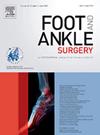Méary's angle decoded: 3D analysis of first ray plantarflexion deformity in Charcot-marie-tooth disease
IF 1.9
3区 医学
Q2 ORTHOPEDICS
引用次数: 0
Abstract
Background
The typical cavovarus deformity seen in patients with Charcot-Marie-Tooth (CMT) involves plantarflexion of the first ray. The exact apex of the deformity has never been proven, although it is presumed to be within the medial cuneiform. The aim of this study was to utilize weight-bearing computed tomography (WBCT) to localize and quantify first ray plantarflexion deformity in CMT patients.
Methods
WBCTs of 16 CMT patients with lateral Méary’s angle > 20 degrees were compared to controls utilizing semi-automated analysis software. A local coordinate system based on the first metatarsal was used to avoid bias of proximal deformity. The tarsometatarsal angle was subdivided into components (cuneiform-cuneiform joint normal, tarsometatarsal joint and metatarsal-metatarsal joint normal) and compared between CMT and controls. CMT patient’s first, second and third rays were also compared. Means were compared with a 2-sample t test (p < .05).
Results
CMT patients had significantly more plantarflexion of the first ray than controls (16.4 versus 8.8 degrees respectively(p < 0.001)). The largest difference of was found at the medial cuneiform with 20.6 degrees of plantarflexion in CMT patients versus 14.8 degrees in controls (p < .0001). There was also approximately 2 degrees of plantarflexion at the TMT joint (p < .001).
Conclusions
Plantarflexion deformity in CMT patients is primarily an osseous deformity at the level of the medial cuneiform with a lesser contribution from the tarsometatarsal joint.
Level of evidence
III Retrospective comparative study
梅里角解码:Charcot-Marie-tooth 病第一缕足底屈曲畸形的三维分析。
背景:Charcot-Marie-Tooth (CMT) 患者的典型腔隙性畸形是第一跖骨跖屈。虽然推测畸形的确切顶点位于楔形内侧,但从未得到证实。本研究的目的是利用负重计算机断层扫描(WBCT)来定位和量化 CMT 患者的第一跖跗关节畸形:方法:利用半自动分析软件将 16 名梅里外侧角大于 20 度的 CMT 患者的 WBCT 与对照组进行比较。采用基于第一跖骨的局部坐标系,以避免近端畸形的偏差。跖跗关节角度被细分为多个部分(楔形关节-楔形关节正常、跖跗关节和跖骨-跖骨关节正常),并在 CMT 和对照组之间进行比较。还比较了 CMT 患者的第一、第二和第三射线。平均值的比较采用 2 样本 t 检验(p 结果:CMT 患者的跖趾关节明显比对照组多:CMT 患者第一条射线的跖屈度明显高于对照组(分别为 16.4 度和 8.8 度):CMT患者的跖屈畸形主要是内侧楔形关节水平的骨性畸形,跖跗关节的影响较小:III 回顾性比较研究。
本文章由计算机程序翻译,如有差异,请以英文原文为准。
求助全文
约1分钟内获得全文
求助全文
来源期刊

Foot and Ankle Surgery
ORTHOPEDICS-
CiteScore
4.60
自引率
16.00%
发文量
202
期刊介绍:
Foot and Ankle Surgery is essential reading for everyone interested in the foot and ankle and its disorders. The approach is broad and includes all aspects of the subject from basic science to clinical management. Problems of both children and adults are included, as is trauma and chronic disease. Foot and Ankle Surgery is the official journal of European Foot and Ankle Society.
The aims of this journal are to promote the art and science of ankle and foot surgery, to publish peer-reviewed research articles, to provide regular reviews by acknowledged experts on common problems, and to provide a forum for discussion with letters to the Editors. Reviews of books are also published. Papers are invited for possible publication in Foot and Ankle Surgery on the understanding that the material has not been published elsewhere or accepted for publication in another journal and does not infringe prior copyright.
 求助内容:
求助内容: 应助结果提醒方式:
应助结果提醒方式:


